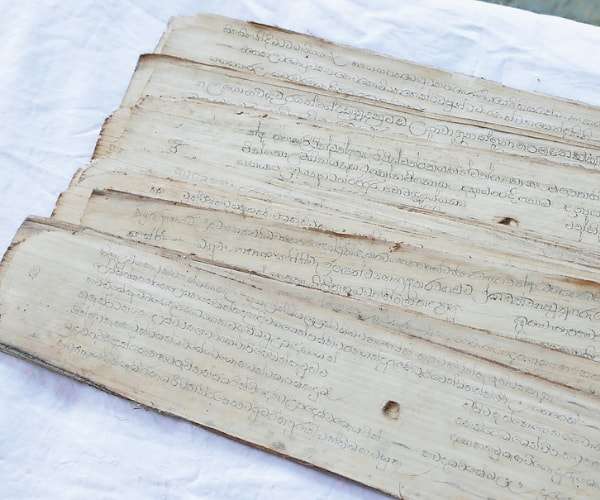
Mar 10 2021.
views 703






Buddha’s teachings were spread as an oral tradition prior to the writing of the Tripitaka. One of the main objectives of writing the Tripitaka (Pali Canon)has been to protect the Dhamma. Codified versions of the Dhamma were written in a way so only those who know the Dhamma could read it accurately. According to historical accounts, events such as the BaminitiyaSaya or the Great Famine led to the writing of the Tripitaka, but this has been subject to debate. This momentous event took place during the reign of King Valagambahu.

Preparing an Ola Leaf
Ola leaves need to be prepared prior to using them as a medium for writing. “Initially the area surrounding the Talipot palm tree (Corypha umbraculifera) is cleared and monks chant pirith before the pad of raw leaves is cut,” said Ven. Galahitiyagama Dhammarathana thera at Sri Jethavana Vihara, Maningamuwa, Pallepola.“It is usually cut two days prior to poya as cutting it on a poya day would cause fungal growth. Once it’s cut, a rope is tied to one end and the pad is lowered so that the leaves will not open up. After being brought down the leaves will be unfolded one by one while removing ekels. The unfolded leaves are then rolled (vattu) into sets prior to boiling it with herbal oils.”
“Keppetiya, bamboo, pineapple, papaya leaves are then added to a pot and the boiled sets of leaves are dried in the sun and in wind, both during the day as well as at night. The dried leaves are rolled once again and after the 14-day process, the leaves will be ready for the final touches. Thereafter the leaves are ironed using a traditional kind of iron. The leaves are then included in moulds made of different sizes. The leaves are pressed into the moulds before heating. The dried leaves are heated to get rid of the moist layer of film that forms on either side of the leaves. Once heated the leaves are now suitable for writing purposes.”
Apanhinda (steel stylus) is used for writing in various fonts including Gaja, Sinha and Hansa. Dummala and Kakuna oils are used to prepare a concoction that is used to darken the letters written on the Ola leaf. The remaining concoction is removed using kurakkan and rice flour. Writing on an Ola Leaf is a form of meditation as it needs a great deal of concentration. The Mahapiritha, sutras including Dhammacakkapavattana sutra, other Buddhist texts, medicinal recipes, chants and many other texts are written on Ola leaves this way.
Debate on the venue
The task of writing the Pali Canon was the responsibility of a contingent of monks who had the ability to retain the words. The Bhanakas, as they were called, were later said to have received different parts of the Tripitaka which they had to write. The earliest accounts mention that the Tripitaka was written at the ‘Aloka Cave of Malaya District in Sri Lanka’. Several schools of historians are divided on this, where some believe that the Tripitaka was written at the Aluvihare in Matale while some others believe that this great event took place at the Alulena Cave situated closed to Karandupona in Kegalle District.
According to Ven. Aththanagoda Somawansa thera, chief incumbent at Alulena Cave Temple, the Maha Sangha took on this Herculean task during the famine. Therefore 500 arhats had to be in a place that had food and water for survival. The surrounds of the Aluvihare and Alulena have been home to forest-dwelling monks. A tank by the name Bodhiwewa too had been there at the time. Historical texts suggest that the route to reach Magadha Kingdom from Anuradhapura was via Molagoda, Alulena in Mathula. In 1852, James De Alwis mentions Matula Alulena in a foreword written to the Sidath Sangarawa of the Nikaya Sangrahaya during the Gampola Period. However, some say Matula Alulena was said to have been misinterpreted as Matale Aluvihare in a book penned by C. W Nicholas and this report was sent to England. According to Somawansa thera, this misinterpretation was included in history books and became popular history. Since initial texts weren’t referred to prior to this misinterpretation, the thera says, Matale Aluvihare was accepted as the venue where this major event took place.
Preserving a tradition
Ola leaf manuscripts have been used to store information in a range of fields including literature, history, Buddhism, Ayurveda medicine, astrology and black magic. Today, writing on Ola leaves is a dying tradition as it’s a tedious process. However, young monks in remote temples are trained to continue the tradition and master the art of writing on ola leaves to ensure its continuity. Initially, they are trained to write proper Sinhala and Pali letters on sand. They are then given what looks like a compass (ulkatuwa) to further masters the skill. Subsequently, arecanuts are suspended on this compass-like instrument to add weight and get used to the panhinda. It is only after a young monk master their letters to perfection that they are given a panhinda to write on the Ola leaves. Back in the day, people have made a living out of the Talipot palm industry. Ola leaf manuscripts have been a highly venerated medium of literature but today, many of Sri Lanka’s manuscripts are available for sale in the local and international domain.
0 Comments